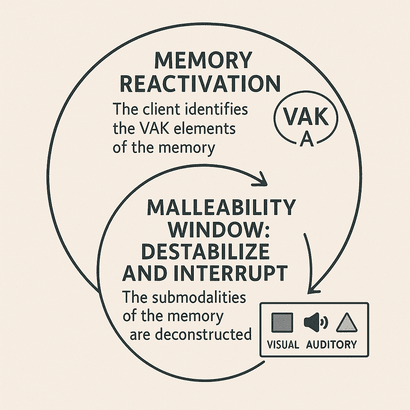Brain-Switch 2.0 ® Explained
Brain-Switch 2.0®: A brain-science approach to dissolving trauma and emotion-based issues
At the heart of Brain-Switch 2.0® lies memory reconsolidation, a scientifically validated process through which reactivated emotional memories become temporarily malleable. During this window of neuroplasticity—lasting minutes to hours—the memory trace can be updated with new information before it re-stabilizes.
Brain-Switch 2.0® leverages this window to reshape the sensory and emotional encoding of distressing memories, resulting in long-term change without the need for prolonged exposure or repeated rehearsal. It is completely content free – bypassing the need to be amygdala centric / retelling of the event.
Three-Step Process of Brain-Switch 2.0®

Applications and Benefits
Brain-Switch 2.0® is especially effective for:
•PTSD,traumatic imprints, Complex trauma and Development Trauma
•Anxiety, Depression and emotion-based issues
•Emotional reactivity in relationships
•Shame, guilt, and long-standing self-concepts
•Non-verbal, somatic memories and emotional patterns
1. Memory Reactivation
The process begins with gently guiding the client to recall a target emotional memory, one with a clear emotional imprint. The goal is to activate the neural representation of the experience just enough to engage it, without overwhelming the client.
• The client identifies the visual, auditory, and kinesthetic (VAK) elements of the memory.
• This includes internal images, sounds, and bodily sensations tied to the event.
2. Malleability Window: Destabilize and Interrupt
Once the memory is active, the practitioner introduces a brief brain-switch – by moving the memory to another location. The goal is to destabilize the fixed narrative or sensory coding of the memory.
• This initiates the reconsolidation window.
• It primes the brain for updating, not just re-experiencing.
3. Submodality Shift and Sensory Recode
With the memory destabilized, the practitioner guides the client in deconstructing the submodalities of the memory:
• Visual
• Auditory
• Kinesthetic
•This sensory editing allows the emotional impact to change at a neural encoding level, leading to a transformation that is felt, not just thought. Over time, the memory retains its factual content but loses its emotional charge or unhelpful associations.
Unlike traditional talk therapy, Brain-Switch 2.0® operates at the level of implicit memory systems—offering resolution even when clients can’t “think” their way out of emotional responses.
Conclusion
Brain-Switch 2.0® represents a next-generation intervention for emotional and trauma-based issues. By tapping into the brain’s natural updating mechanisms and integrating submodality work from NLP and somatic models, it offers a rapid, sustainable path to emotional relief. Memories are not erased, but their influence is transformed—liberating clients from past pain and opening the door to new behavioral and emotional possibilities.
